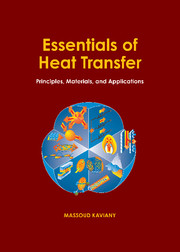Book contents
- Frontmatter
- Contents
- Preface
- Acknowledgments
- Guide to Instructors and Students
- 1 Introduction and Preliminaries
- 2 Energy Equation
- 3 Conduction
- 4 Radiation
- 5 Convection: Unbounded Fluid Streams
- 6 Convection: Semi-Bounded Fluid Streams
- 7 Convection: Bounded Fluid Streams
- 8 Heat Transfer in Thermal Systems
- Nomenclature
- Glossary
- Answers to Problems
- Appendix A Some Thermodynamic Relations
- Appendix B Derivation of Differential-Volume Energy Equation
- Appendix C Tables of Thermochemical and Thermophysical Properties
- Subject Index
8 - Heat Transfer in Thermal Systems
Published online by Cambridge University Press: 05 June 2012
- Frontmatter
- Contents
- Preface
- Acknowledgments
- Guide to Instructors and Students
- 1 Introduction and Preliminaries
- 2 Energy Equation
- 3 Conduction
- 4 Radiation
- 5 Convection: Unbounded Fluid Streams
- 6 Convection: Semi-Bounded Fluid Streams
- 7 Convection: Bounded Fluid Streams
- 8 Heat Transfer in Thermal Systems
- Nomenclature
- Glossary
- Answers to Problems
- Appendix A Some Thermodynamic Relations
- Appendix B Derivation of Differential-Volume Energy Equation
- Appendix C Tables of Thermochemical and Thermophysical Properties
- Subject Index
Summary
Chapter 8 is found on the Web site www.cambridge.org/kaviany. Chapter 8 is about heat transfer analysis and addresses control of heat transfer, in conjunction with energy storage and conversion, for innovative applications and optimized performance in thermal systems. This heat transfer can occur at various, cascading length scales within the system. The analysis is done by modeling the transport, storage, and conversion of thermal energy as thermal circuits. The elements of these circuits, i.e., mechanisms and models of resistances, storage, and energy conversion, have been discussed in Chapters 2 to 7. In this chapter we consider their combined usage in some innovative, significant, and practical thermal systems. We begin by addressing the primary thermal functions of heat transfer media and bounding surfaces. Then we summarize the elements of thermal engineering analysis. These include the need for assumptions and approximations for reduction of the physical models and conceptual thermal processes to thermal circuit models. Next we give five examples (Examples 8.1 to 8.5), in detail, to demonstrate the application of the fundamentals and relations developed in the text, along with the use of software. The examples are selected for their innovative potentials. There are also five end-of-chapter problems (Problems 8.1 to 8.5).
- Type
- Chapter
- Information
- Essentials of Heat TransferPrinciples, Materials, and Applications, pp. 659 - 660Publisher: Cambridge University PressPrint publication year: 2011



